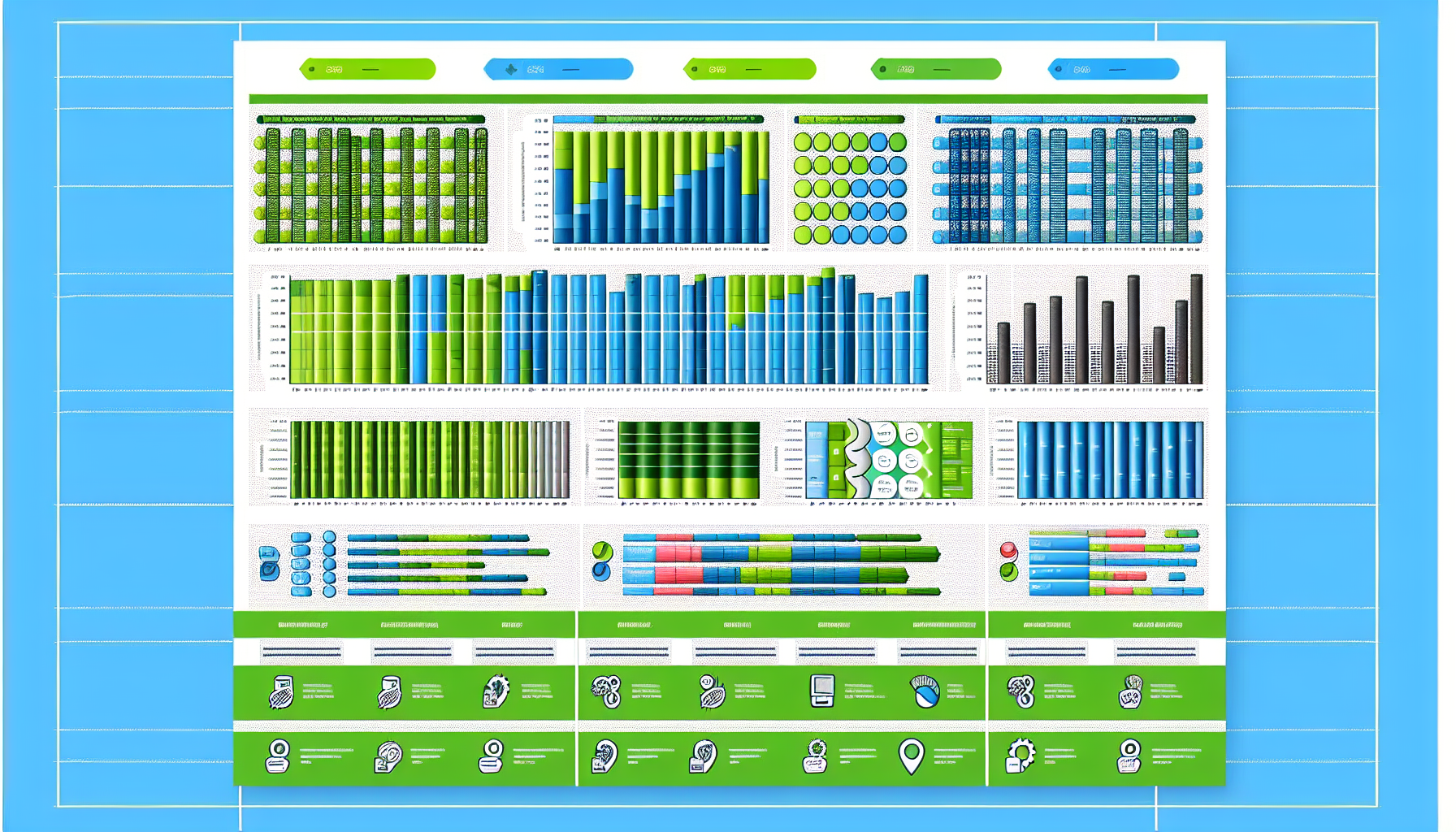How to Write Product Comparison in 2024

In today’s market, where consumers are spoilt for choice, product comparisons stand as a beacon of light guiding customers through the labyrinth of options. A well-crafted product comparison chart can be a lifeboat in the sea of indecision, helping customers make informed decisions and boosting conversions and sales for businesses.
Key Takeaways
- Mastering product comparison involves understanding customer needs, highlighting advantages and disadvantages, showcasing reviews & ratings, utilizing visual data representation tools and interactive comparison tools.
- Marketing strategies such as content marketing can be used to promote product comparisons while case studies demonstrate how successful companies have utilized them effectively.
- Prioritizing information is key when creating a comprehensive comparison page for customers to make informed decisions.
Decoding the Art of Product Comparison

Product comparisons are more than just a listing of features or a side-by-side display of products. They serve as a strategic tool that provides a comprehensive comparison of different product options, highlighting their differences and similarities to aid consumers in selecting the most appropriate product for their needs. A visually appealing product comparison page can have a substantial impact on conversions and sales. But how do we create such a page? How do we decide what features to include and what to leave out? How do we present the data in a manner that is easy to understand and yet detailed enough to be useful?
The key lies in understanding the product, the competitors, and most importantly, the customers. Comparing products allows customers to evaluate different options based on their features and benefits, leading to more informed decisions, higher customer satisfaction, and increased sales.
Essentially, a successful product comparison page should include:
- Pertinent features
- Specifications
- Prices
- Availability
- Reviews
- Ratings
- Warranty terms
- Delivery options
Providing key information in an organized manner is crucial for an effective comparison.
Understanding Different Products Through Comparative Analysis
When it comes to comparing products, it’s not just about listing the features. It’s about understanding the products, their unique selling points, and how they meet the needs of the customer. Comparing a new phone with its competitors, for example, requires understanding the stand-out features and benefits of the phone and how it meets the needs of the customers.
Consistency in product comparisons is crucial to prevent rendering the comparison unreliable, especially when comparing similar products. Tailoring a product comparison to fit a customer’s decision-making process requires comprehension of the customer’s decision criteria, analysis of the products to pinpoint their unique features, and presentation of details with a customer-focused approach.
With more than a decade of experience in the industry, SEO professionals have developed various strategies to optimize product comparisons for better customer engagement.
Identifying Key Features That Matter
While comparing products, one must remember that not all different features carry equal weight. Customers should prioritize the features and aspects that are most relevant to their needs, including price, quality, and distinctive product features. Additionally, they should consider consumer reviews and ratings as part of their evaluation process.
Understanding customers is essential in product comparison as it helps in identifying the main segments they belong to. This understanding enables the customization of product promotion for specific segments, emphasizing relevant features or providing alternatives for segments not addressed by the products being compared. Dynamic Spec Relativity is one such methodology used to prioritize the most important features in a product comparison, ensuring that the key aspects valued by customers are effectively highlighted.
Crafting Your Own Product Comparison Chart

Given our understanding of product comparison and its importance, it’s time to get to work and construct our own product comparison chart. Despite seeming challenging, this task becomes more approachable when broken down into simpler steps. The first step is to decide on the number of products being compared and the number of features being compared. The layout of the chart and the visual design are equally crucial to ensure the information is easily comprehensible and visually attractive.
Improving the visual appeal of product comparisons involves:
- Listing features in the middle
- Displaying recognizable product shots, such as in an iPhone vs Samsung chart
- Adhering to standard layouts and designs
- Keeping text brief and to the point
- Utilizing color-coding
- Incorporating images, as demonstrated by companies like Keurig.
Prioritizing information and structuring it into sections with clear headers is essential for a comparison chart as it facilitates quick scanning and enhances user comprehension of the data at a glance. To streamline the process of creating product comparison charts multiple times, one can utilize a standardized product comparison template or a comparison chart template.
Selecting the Right Tools for Your Comparison Chart
With the basics of chart creation under our belt, it’s time to dive into the tools that can aid this process. When selecting tools for creating product comparison charts, it is important to consider factors such as ease of use, customization options, available templates, and the necessity of design experience. Some of the most effective software tools for creating product comparison charts are:
- Jira Software
- Lucidchart
- Microsoft Visio
- SmartDraw
- Canva
Another tool worth mentioning is Lasso, a plugin that enables seamless generation of product comparison tables. It offers functionalities such as:
- Customizable star ratings
- Banners
- Selectable button colors
- The option to incorporate custom fields for comparing product specifications or features.
For individuals without design experience, Venngage provides a drag-and-drop editor along with a free comparison infographic template, allowing them to effortlessly create professional-looking comparison charts.
Incorporating Design Elements for Enhanced Clarity

Even a thorough product comparison chart can lose its impact if it lacks visual appeal. Hence, integrating design elements to improve the chart’s clarity and readability is crucial. Utilizing color-coding allows for the assignment of specific colors to different metrics or types of information, ultimately facilitating quick comprehension for readers.
Icons serve as a visual shorthand and contrast against solid color backdrops to draw attention to specific parts of a comparison infographic. They can enhance the appeal of an option and provide clarity on the superiority of one option over others. An effective quadrant comparison infographic can be heightened by incorporating arrows to indicate the flow of information, while a Venn diagram can be made more effective by using brightly contrasting colors and icons to visually differentiate overlapping and unique features of compared products.
Lastly, utilizing large, bold fonts with contrasting colors can effectively highlight key numbers or statistics, ensuring their easy noticeability.
The Role of Competitor Analysis in Product Comparisons
The success of a product comparison depends not only on knowing your own product but also on comprehending your competitors’ offerings. Competitor analysis involves the identification and research of competitors to gain insights into their:
- strengths
- weaknesses
- products
- marketing strategies
This evaluation helps businesses assess how well their products or services compare to those of their competitors.
Comprehending competitors is essential when developing a product comparison chart as it enables a comprehensive understanding of the strengths and weaknesses of competitors’ products. This understanding facilitates the identification of unique selling points for one’s own product and effective differentiation in the comparison chart. Competitor analysis enhances the effectiveness of product comparisons by offering valuable insights into the positioning of your product in relation to competitors, highlighting its distinct selling propositions and areas for enhancement.
Additionally, it provides valuable information on market trends and consumer preferences, facilitating improved product positioning and differentiation in the market.
Prioritizing Information: What to Include in Your Comparison
The abundance of product features can sometimes be daunting. Thus, it’s essential to prioritize information that holds the most relevance and value for the customer. This involves:
- Understanding the needs and preferences of your audience
- Emphasizing benefits over a long list of features
- Grouping similar features into themes for simplicity
Critical factors to be evaluated when prioritizing product comparison information include customer needs, feasibility, desirability, viability, urgency, importance, value versus effort, and customer preferences. These factors can vary depending on the audience and product type. To identify the most pertinent information for customers in product comparisons, one can utilize strategies such as placing similar features up front, highlighting unique and exclusive details, including social proof such as customer reviews, and gaining a deep understanding of the customer base.
Highlighting Advantages and Disadvantages
In any product comparison, it is essential to highlight the advantages and disadvantages of each product. This not only provides customers with a balanced view but also helps them weigh their options effectively. There are several effective methods for presenting the advantages and disadvantages of a product, including:
- Live product demonstrations or webinars
- Display advertising
- Product placement
- Pros and cons templates
- Engaging key opinion leaders
- In-person event marketing
- Leveraging salespeople expertise
To present product advantages and disadvantages in an informative and unbiased manner, it is important to follow best practices. These include:
- Conducting thorough research to gather accurate information
- Maintaining objectivity in language to avoid skewing the reader’s opinion
- Supporting claims with evidence such as data and real-life examples
- Considering different user perspectives to provide a balanced view
- Comparing the product with alternatives to clarify its position
- Using clear and concise language to ensure understanding
By following these best practices, you can effectively present the advantages and disadvantages of a product in a fair and informative way.
The recommended method for visually representing product advantages and disadvantages in a comparison chart is to use a two-column table format, with one column dedicated to advantages and the other to disadvantages.
Showcasing Customer Reviews and Ratings
Reviews and ratings form a crucial part of any product comparison. They provide an unbiased view of the product from the perspective of those who have used it. Incorporating customer reviews and testimonials in a product comparison page is essential for building trust and enhancing reputation with potential clients.
However, not all reviews and ratings are authentic. An effective approach for validating the legitimacy of customer reviews and ratings involves examining patterns and consistency in the reviews. Authentic reviews typically contain specific details and offer a well-rounded perspective. Cross-referencing reviews across various platforms can aid in identifying any inconsistencies or questionable patterns. It is therefore recommended to exercise caution when considering the reviews and ratings on a product comparison page.
Visual Data Representation: Graphs, Charts, and More

Adding visual elements to a product comparison can make it more engaging and informative. Create custom charts to effectively showcase variations in metrics across different segments, enhancing the visual and straightforward nature of the comparison for users. Commonly utilized charts for product comparisons include pie charts, which are used to display proportionate data, and bar graphs, which are used to compare discrete quantities.
One can enhance the engagement of a bar graph in a product comparison chart by highlighting specific data points with distinct colors or embellishing it with icons. These visual elements not only make the comparison more engaging but also make the information easier to comprehend.
Enhancing User Experience with Interactive Comparison Tools
In the current digital era, interactivity plays a significant role in improving user experience. Interactive comparison tools streamline customer decision-making in product comparisons by providing easy comparisons, time-saving features, enabling unbiased evaluations, promoting understanding, and assisting in value assessments. The most effective interactive comparison tools for improving user experience in product comparison are Userpilot, Balsamiq, Adobe XD, Figma, Sketch, and Invision.
The recommended steps for integrating interactive comparison tools into a product comparison website include:
- Choosing the right CMS or considering using dedicated product comparison software
- Making the comparison table easy to scan for differences, similarities, and keywords
- Sticking to the standard table layout for clarity
- Creating an interactive comparison chart that allows users to compare products, features, companies, and more
- Using a product comparison widget to display comparing details on different products and services
- Providing a user-friendly interface for shoppers to select the items they want to compare side-by-side
- Considering offering additional options for a better user experience, such as filtering or sorting capabilities.
Making Informed Choices: Analyzing Product Specifications
A thorough analysis of product specifications is essential to help customers make informed choices. Various product categories may have distinct typical product specifications, including:
- Technical classification
- Consumer purchasing patterns
- Similarity to rival brands
- Product requisites
It is crucial to take these specifications into account when evaluating and contrasting products to make well-informed decisions.
The process of analyzing product specifications entails:
- Thoroughly reading the specifications
- Identifying key features
- Comparing specifications with others
- Considering performance metrics
- Evaluating compatibility
- Seeking out additional or special features
- Researching unfamiliar terms
- Considering user reviews
By following these steps, you can gain a thorough understanding of all the features, capabilities, and limitations of the product.
Presenting Multiple Options Without Overwhelming Users
Offering numerous product options can potentially result in information overload, leading to customer confusion and indecision. Hence, it’s important to provide a manageable set of options, ideally between 3 to 7, to avoid overloading users with too much information.
Some effective strategies for emphasizing key features when presenting multiple product options include:
- Understanding the needs and preferences of your audience
- Emphasizing benefits over a long list of features
- Grouping similar features into themes for simplicity
- Engaging users with interactive elements
- Providing follow-up materials to highlight these key features
Information design contributes to streamlining the presentation of multiple product options by:
- Organizing data in a value-focused, meaningful format
- Limiting choice complexity
- Employing consistent and intuitive visual cues
- Articulating options through clear and concise descriptions.
Marketing Your Comparison: Attracting and Retaining Consumers
Once an effective product comparison is established, the subsequent step is its strategic marketing to draw in and retain customers. Some effective marketing strategies for promoting product comparisons include:
- Utilizing email marketing
- Creating blog posts
- Hosting events
- Encouraging customer reviews
- Sharing on social media
- Running Facebook ads
Content marketing can enhance the visibility of product comparison charts through:
- Creation of informative and educational content
- Sharing on social media
- Search engine optimization
- Influencer collaboration
- Incorporation into email marketing
- Utilization of visual elements
Crowdsourcing reviews and statistics from various individuals can offer a broader and more comprehensive viewpoint on the product being compared, assisting consumers in making well-informed decisions. Incorporating generic testimonials is crucial as they offer sustainability and currency compared to specific reviews from years past, thereby preserving the relevance and authenticity of the product comparison.
Case Studies: Success Stories in Product Comparison
Now that we have discussed the importance of product comparisons and the various elements involved in creating an effective product comparison, let’s look at some real-world examples. Several companies, such as Sketch, Fathom, and Confiture, have effectively utilized product comparison pages to highlight their features, differentiate their products from competitors, and assist users in evaluating different options.
Amazon’s use of product comparison greatly contributed to building customer trust, offering a platform for effortless product comparison, access to in-depth information and customer reviews, and transparency in pricing. This commitment to transparency and convenience in facilitating well-informed purchasing decisions contributed significantly to Amazon’s establishment as a reputable hub for online shopping.
Best Buy strategically leveraged product comparisons by enabling customers to:
- Make side-by-side comparisons of various products
- Enrich their shopping experience
- Facilitate more informed decision-making
- Increase the likelihood of purchase completion
Summary on Product Comparison
In conclusion, product comparisons are a powerful tool that can dramatically enhance customer decision-making and boost conversions and sales. Whether you are a business looking to create an effective product comparison chart or a customer looking to make an informed purchase decision, understanding the art of product comparison is essential. Remember, the key to a successful product comparison lies not just in listing product features but in understanding the unique selling points of each product, the competitors, and most importantly, the customers.
Frequently Asked Questions on Product Comparison
What is product comparison?
Product comparison is a process of comparing your product’s features and benefits to those of competitors, helping you identify areas of improvement and informing future product development.
How do you create a product comparison report?
To create a product comparison report, one should start by establishing their market position, identify needs and opportunities, compare features, discover trends, optimise marketing campaigns, identify competitors, gather consumer data from reviews, and conduct further market research.
How do you show product comparison?
To demonstrate product comparison, one should use tables or charts that include product names, descriptions, and specs side-by-side for an easy comparison.
How to compare 4 items?
To compare four items, use a quadrant layout to separate and differentiate the four options. This is an effective way to compare multiple items side-by-side.
How many products should be compared to avoid information overload?
To avoid information overload, it is best to present 3-7 options for comparison.


